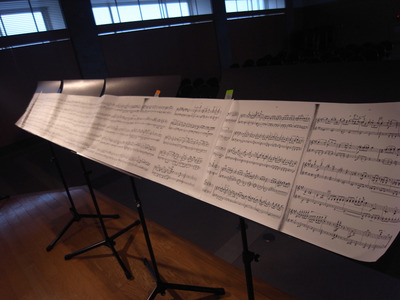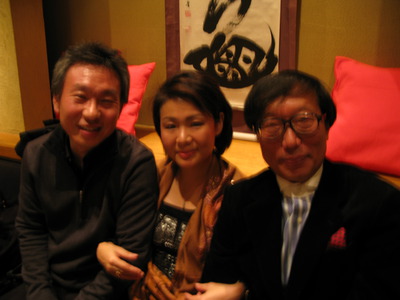I am presently rehearsing for a concert in Chiba City (an hour's drive from Tokyo) in two days. This concert is sponsored by Komai Tekko Inc., a leading company in Japan which specializes in design and installation of long bridges, elevated highways, and wind power systems.
As the last piece of this concert, I chose a sonata by Ysaÿe for two violins and invited a long time friend, Tracy, to fly in from Taipei. Subsequently we agreed to play the same piece again in a different concert in Taipei later in the month.
Right now I have two concerns : first, the latest weather forecast which is predicting a typhoon to arrive on the date of the concert; the second, while we are performing, there are no convenient spots to turn the music scores throughout each movement. Of course, this would not be a problem if we memorize the entire twenty five minutes piece.
In the case of Prokofiev's sonata for two violins, we face a similar difficulty on deciding when to turn pages in a very short time. In most other pieces, however, there are usually suitable places to do so.
After struggling for a while, we experimented spreading the sheets of music over four music stands and tried moving to the right as each movement progressed. This method was troublesome because the first movement had sixteen pages; the second, nine pages; and the third, twelve pages. Therefore, we first laid the pages for the third movement on the music stands, then on top of them, we placed the pages for the second movement, and finally the pages for the first movement. When we finished playing one movement, we had to remove the pages of what we had just played. Unfortunately this removing process took too much time and affected the flow of music.
What to do?
A manager at the Komai Tekko Inc. came up with an innovative proposal. In his line of business, sometimes his designers have to create an unusually long, continuous document. This document is then rolled up into a scroll and is carried around from place to place. Thanks to this brilliant idea, we had a scroll of music made for each movement in no time. This way we were able to keep the break between movements to a minimum.
Attached below is a photograph of the super-long music score. Later I will carefully carry these scrolled scores to Taipei and use them again at a concert.

As the last piece of this concert, I chose a sonata by Ysaÿe for two violins and invited a long time friend, Tracy, to fly in from Taipei. Subsequently we agreed to play the same piece again in a different concert in Taipei later in the month.
Right now I have two concerns : first, the latest weather forecast which is predicting a typhoon to arrive on the date of the concert; the second, while we are performing, there are no convenient spots to turn the music scores throughout each movement. Of course, this would not be a problem if we memorize the entire twenty five minutes piece.
In the case of Prokofiev's sonata for two violins, we face a similar difficulty on deciding when to turn pages in a very short time. In most other pieces, however, there are usually suitable places to do so.
After struggling for a while, we experimented spreading the sheets of music over four music stands and tried moving to the right as each movement progressed. This method was troublesome because the first movement had sixteen pages; the second, nine pages; and the third, twelve pages. Therefore, we first laid the pages for the third movement on the music stands, then on top of them, we placed the pages for the second movement, and finally the pages for the first movement. When we finished playing one movement, we had to remove the pages of what we had just played. Unfortunately this removing process took too much time and affected the flow of music.
What to do?
A manager at the Komai Tekko Inc. came up with an innovative proposal. In his line of business, sometimes his designers have to create an unusually long, continuous document. This document is then rolled up into a scroll and is carried around from place to place. Thanks to this brilliant idea, we had a scroll of music made for each movement in no time. This way we were able to keep the break between movements to a minimum.
Attached below is a photograph of the super-long music score. Later I will carefully carry these scrolled scores to Taipei and use them again at a concert.


